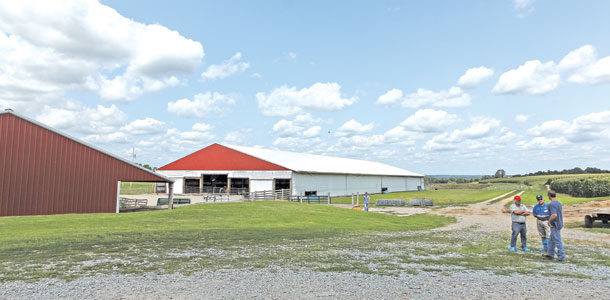Around the world and back again, the eighth annual Kentuckiana Dairy Exchange on July 29-30 covered a lot of ground. Not only did 100 attendees from both states visit five central Kentucky farms selected for top-notch management, high production, low somatic cell counts and great on-farm innovation, they also heard about dairying in Europe and early lameness detection with keynote speaker Dr. Nicola Blackie, Writtle College, England, and about a recent Indiana Department of Agriculture trade mission to Asia from Indiana Dairy Producers executive director Doug Leman.
Located this year in central Kentucky, the event is organized annually by the University of Kentucky (UK) and Purdue extension and is promoted by the Kentucky Dairy Development Council (KDDC) and the Indiana Dairy Producers (IDP).
IDP president Steve Obert, whose Indiana dairy is located just 25 miles from the Kentucky border, said the group from Indiana found “a lot of ideas to take north.”
“We picked dairies that have features of interest to other producers and with intergenerational transfer,” said UK’s Dr. Jeffrey Bewley. Low somatic cell counts were a primary feature, showing “we can achieve high-quality milk in the South,” said Bewley. Automated calf feeding, heat-detection systems and bedded-pack barns offering flexibility for expansion were added highlights.

The event kicked off at Compton Dairy, named 2013 Kentucky State Fair Milk Quality Grand Champion Farm, and Hutchison Holsteins, another top dairy for production and milk quality.
Tony and Ben Compton reduced their 200-cow SCC to average 70,000 to 80,000. The first drop came when they built a freestall barn six years ago to bring cows into a more controlled environment. They also focus on keeping a dry parlor. “We put no water on the cows, and our milkers wear gloves,” said Tony.
Dave Hutchison and nephew Matt Sabo operate Hutchison Holsteins, where 125 cows are milked 3X and produce a 28,900-pound RHA with SCC averaging 160,000. Not long ago, production was barely 18,000 pounds. That changed when Hutchison moved cows into year-round housing, transitioned from all hay and pasture to a corn silage-based ration and added a third daily milking.

The corn silage is custom-harvested by a large grain operator in the area. “He knows corn, and we concentrate on the cows,” Hutchison explained.
At Corbin Dairy, former tobacco farmer David Corbin took over his parents’ small dairy and expanded internally to 300 cows. They have sand-bedded freestalls and a bedded-pack barn using fine-particle sawdust from cabinet makers. It looks like sand but is dustier.
Bewley’s team of students recently completed a study there comparing a heat-detection system to a synchronization program. Corbin confirmed that while there were differences in how they got there, the reproductive performance improved dramatically for both groups of animals, so the end result was about the same level of improvement under both systems.

Corbin Dairy grows all their own corn silage and have their extra corn shelled. They also chop wheat then roll what is left as a “wet wrap” feed for heifers and dry cows.
“We really try to chop corn silage at the optimal time,” Corbin noted. “Going from 90 cows and grazing to 300 cows on a TMR, I’ve learned that if the silage isn’t right, we end up with a full year of lower production.”
At Sidebottom Dairy, attendees were interested in the new milking parlor and successful multi-generation farm transition. Jim and Ona and their son Stacy milk 250 cows, and Jim was an original founder of KDDC.
The Sidebottoms milk 2X, and milk their early lactation cows 4X until they reach 80 days in milk. “The cows do well in this system – giving an average of 10 to 12 pounds more milk – and it solves the problem of finding milkers for that night shift in 3X.”

Jim prefers his freestalls for cleanliness, but the bedded pack allows cows to stay milking a few more years with added cow comfort, he observed. “Our SCC runs 200,000 to 210,000 for the whole herd, and we see no difference in mastitis rates between the two barns,” he says.
At Cowherd Dairy, a new calf barn with automated feeders and group housing was the highlight, along with a remodeled parlor.
Click here to view a slideshow with more images from the Kentuckiana Dairy Exchange.
Tony Cowherd is the fifth generation marking the transition from “being the labor to hiring the labor,” as he puts it. He and his father, James Archie, purchased the 60-cow herd in 2006 and built everything themselves to expand to 200 cows. A bedded-pack barn for 100-plus cows helped add herd size. “Future decisions will depend on whether the sixth generation wants to do this,” he added. PD
Sherry Bunting is a freelance writer based in East Earl, Pennsylvania.
PHOTOS
PHOTO ONE: 100 attendees from both Kentucky and Indiana visited five central Kentucky farms selected for top-notch management, high production, low somatic cell counts and great on-farm innovation.
PHOTO TWO: Compton Dairy was the Grand Champion Milk Quality Farm at the 2013 Kentucky State Fair. They put credit for some of their SCC drop into the 80,000 range on bringing cows into a more controlled environment with the building of a freestall barn 6 years ago. They keep the curtains closed year-round, creating a wind tunnel effect with the fans positioned along the feed alley and freestalls.
PHOTO THREE: Former tobacco farmer Dave Corbin “lives and breathes cows” and is continually innovating. He has adapted cheese vats for use as waterers, which did not freeze even during the colder temperatures experienced this past winter.
PHOTO FOUR: The automated calf feeder at Corbin Dairy is housed in an old freezer truck box, which provides insulation from heat and cold. It was added to the end of an existing structure on the dairy where the calf groups are housed to have access to the feeder.
PHOTO FIVE: Indiana and Kentucky dairy producers check out the feed at Hutchison Holsteins in Adair County, Kentucky. Photos courtesy of Sherry Bunting.



